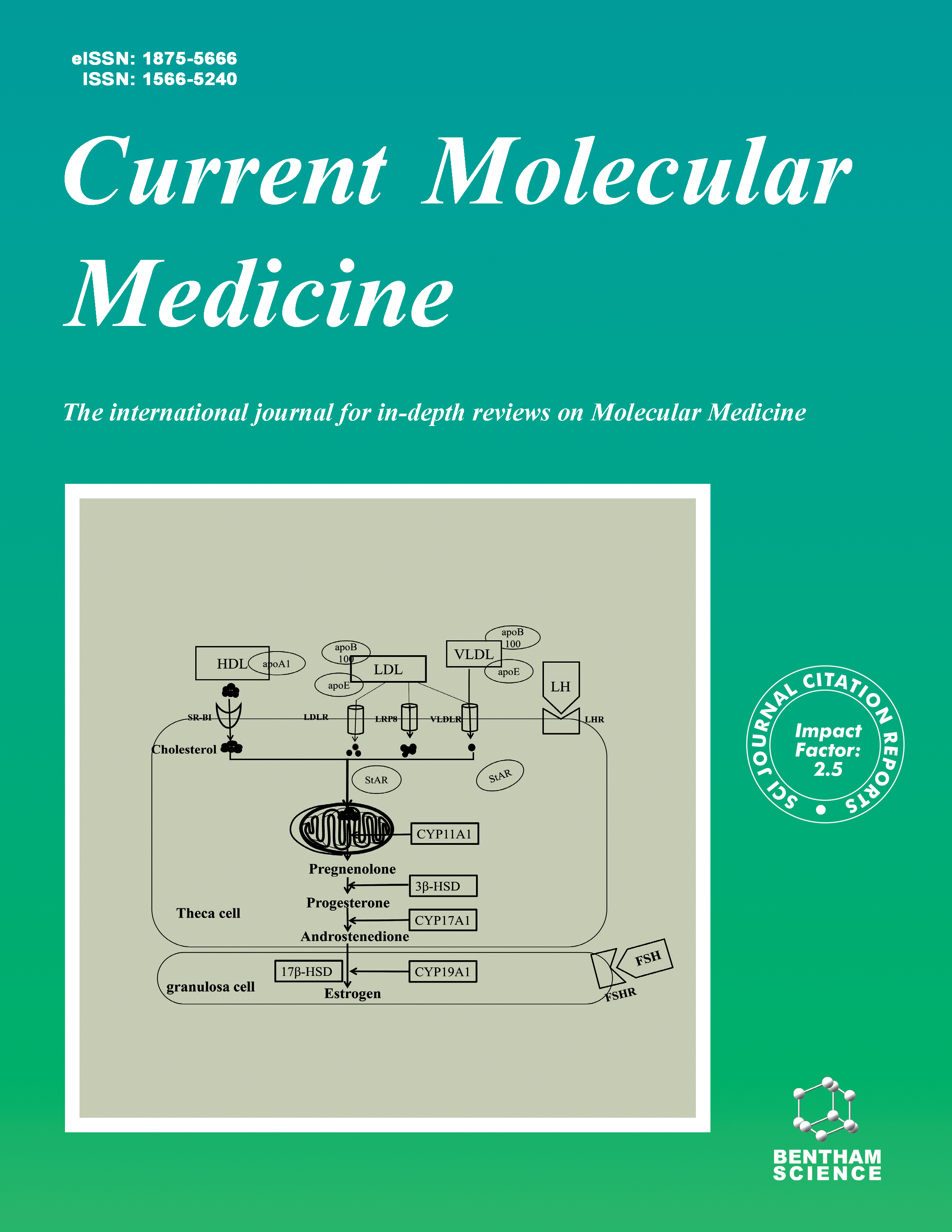- Home
- A-Z Publications
- Current Molecular Medicine
- Previous Issues
- Volume 12, Issue 1, 2012
Current Molecular Medicine - Volume 12, Issue 1, 2012
Volume 12, Issue 1, 2012
-
-
Editorial (Another Year of Prosperity for Current Molecular Medicine)
More LessBy David W. LiAs a bimonthly journal publishing peer-reviewed articles in the field of biomedicine, Current Molecular Medicine continues to move up with the most recent impact factor reported to be 5.212. This is derived from the hard work and collaborative efforts of the Editorial Board. In marching into 2012, we will keep this high spirit and continue to publish high qualities of review and research articles in the biomedical sciences. In the Read More
-
-
-
The TWEAK-Fn14 System: Breaking the Silence of Cytokine-Induced Skeletal Muscle Wasting
More LessAuthors: S. Bhatnagar and A. KumarThe occurrence of skeletal muscle atrophy, a devastating complication of a large number of disease states and inactivity/disuse conditions, provides a never ending quest to identify novel targets for its therapy. Proinflammatory cytokines are considered the mediators of muscle wasting in chronic diseases; however, their role in disuse atrophy has just begun to be elucidated. An inflammatory cytokine, tumor necrosis fact Read More
-
-
-
Trends in Wound Repair: Cellular and Molecular Basis of Regenerative Therapy Using Electromagnetic Fields
More LessAuthors: G.-E. Costin, S. A. Birlea and D. A. NorrisChronic ulceration of the leg represents a major, underestimated problem of modern health care, involving physical and cosmetic impairment and social stigma along with high community costs for patients' treatment. The increasing prevalence of chronic ulcers, currently reported to be as much as 0.3% in the general population, should stimulate identification of more efficacious therapeutic approaches to achieve complete Read More
-
-
-
miR221/222 in Cancer: Their Role in Tumor Progression and Response to Therapy
More LessAuthors: M. Garofalo, C. Quintavalle, G. Romano, C. M. Croce and G. CondorellimiRNAs are small non-coding RNAs of ~24 nt that can block mRNA translation and/or negatively regulate its stability. There is a large body of evidence that dysregulation of miRNAs is a hallmark of cancer. miRNAs are often aberrantly expressed and their function is linked to the regulation of oncogenes and/or tumor suppressor genes involved in cell signaling pathway. miR-221 and miR-222 are two highly homologous micro Read More
-
-
-
Hematopoietic Stem Cells: Transcriptional Regulation, Ex Vivo Expansion and Clinical Application
More LessAuthors: R. Aggarwal, J. Lu, V. J. Pompili and H. DasMaintenance of ex vivo hematopoietic stem cells (HSC) pool and its differentiated progeny is regulated by complex network of transcriptional factors, cell cycle proteins, extracellular matrix, and their microenvironment through an orchestrated fashion. Strides have been made to understand the mechanisms regulating in vivo quiescence and proliferation of HSCs to develop strategies for ex vivo expansion. Ex vivo Read More
-
-
-
Nitric Oxide and Cancer: The Emerging Role of S-Nitrosylation
More LessAuthors: E. Aranda, C. Lopez-Pedrera, J. R. De La Haba-Rodriguez and A. Rodriguez-ArizaNitric oxide (NO˙) is a short-lived, endogenously produced gas that is highly diffusible across cell membranes and acts as a signaling molecule in the body. The redox state and chemistry of NO˙ facilitate its interaction with various proteins thus regulating various intracellular and intercellular events. One of the key mechanisms by which NO˙ regulates the function of various target proteins is through the coupling of a nitroso m Read More
-
-
-
The Emerging Role of Endocrine Disruptors in Pathogenesis of Insulin Resistance: A Concept Implicating Nonalcoholic Fatty Liver Disease
More LessAuthors: S. A. Polyzos, J. Kountouras, G. Deretzi, C. Zavos and C. S. MantzorosEndocrine disruptors or endocrine-disrupting chemicals (EDCs) represent a highly heterogeneous group of molecules found in the environment or in consumer products. Toxicology and epidemiology studies have suggested the involvement of diverse EDCs in an increasing number of metabolic disorders, including insulin resistance (IR) and IR-related co morbidities, such as obesity, type 2 diabetes mellitus (T2DM) and polycystic Read More
-
-
-
HCV Infection by Cell-to-Cell Transmission: Choice or Necessity?
More LessAuthors: G. Carloni, A. Crema, M. B. Valli, A. Ponzetto and M. ClementiIn vitro models of HCV infection have allowed for the clarifying of molecules and mechanisms involved in the main steps of virus cell-entry. HCV entry and neutralization appear to be closely related. Neutralizing antibodies inhibit the E2-CD81 binding, therefore CD81 is considered to be a major target of immune response. The tight-junction proteins are also implicated in E2-binding to CD81 and successive steps of virus ent Read More
-
-
-
Basal Breast Cancer: A Complex and Deadly Molecular Subtype
More LessAuthors: F. Bertucci, P. Finetti and D. BirnbaumDuring the last decade, gene expression profiling of breast cancer has revealed the existence of five molecular subtypes and allowed the establishment of a new classification. The basal subtype, which represents 15-25% of cases, is characterized by an expression profile similar to that of myoepithelial normal mammary cells. Basal tumors are frequently assimilated to triple-negative (TN) breast cancers. They display epi Read More
-
Volumes & issues
-
Volume 25 (2025)
-
Volume 24 (2024)
-
Volume 23 (2023)
-
Volume 22 (2022)
-
Volume 21 (2021)
-
Volume 20 (2020)
-
Volume 19 (2019)
-
Volume 18 (2018)
-
Volume 17 (2017)
-
Volume 16 (2016)
-
Volume 15 (2015)
-
Volume 14 (2014)
-
Volume 13 (2013)
-
Volume 12 (2012)
-
Volume 11 (2011)
-
Volume 10 (2010)
-
Volume 9 (2009)
-
Volume 8 (2008)
-
Volume 7 (2007)
-
Volume 6 (2006)
-
Volume 5 (2005)
-
Volume 4 (2004)
-
Volume 3 (2003)
-
Volume 2 (2002)
-
Volume 1 (2001)
Most Read This Month
Article
content/journals/cmm
Journal
10
5
false
en


